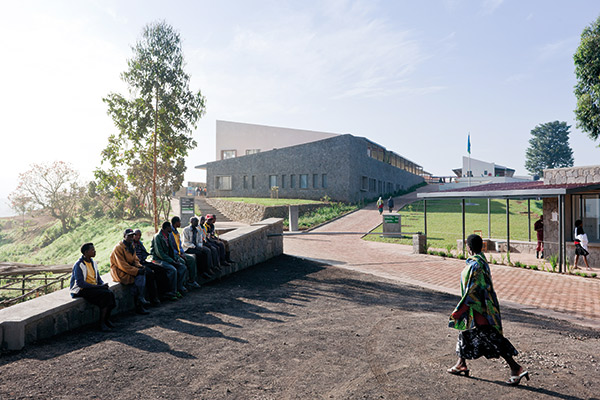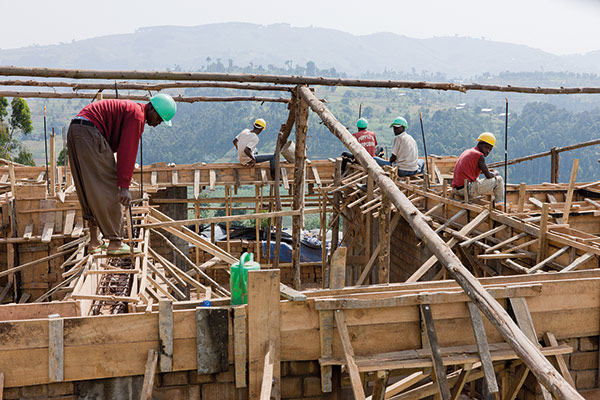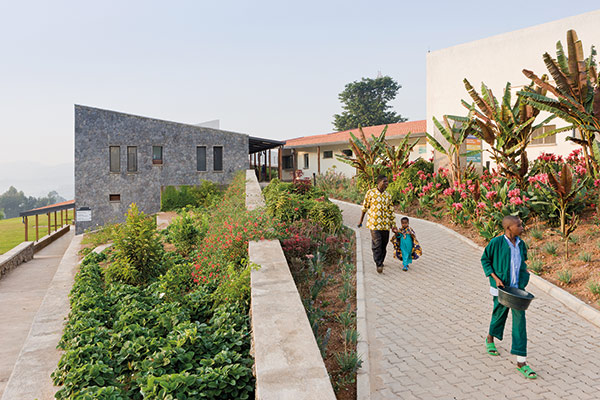Subtotal: $
Checkout
Architecture for Humans
Can people live in hope if their homes and places of work do not nurture and celebrate life?
By Norman Wirzba
December 12, 2023
Available languages: Español
Next Article:
In the concluding lines of “The Hell of Treblinka,” one of the first published essays on the Nazi death camps, Vasily Grossman writes that lovers of humanity must always bear a simple truth in mind: “It is possible to demonstrate with nothing more than a pencil that any large construction company with experience in the use of reinforced concrete can, in the course of six months and with a properly organized labor force, construct more than enough chambers to gas the entire population of the earth.” Construction workers didn’t need much time to build a factory of death. They didn’t need much space either: “Ten small chambers – hardly enough space, if properly furnished, to stable a hundred horses – ten such chambers turned out to be enough to kill three million people.”
The architectures of terror, dehumanization, and killing were remarkably easy to build. Several of the characteristics prized by modern technocratic reasoning – precise calculation and control, maximization of yield, and machine efficiency – were put to work in the camps’ design, construction, and operation. Surveying them, Grossman was struck by how much the layout and the buildings followed the principles of any large-scale modern industrial enterprise.
It is tempting to dismiss Treblinka as an especially egregious manifestation of the architecture of hell. We shouldn’t. Grossman was a war correspondent for the Russian army newspaper Red Star. He traveled across much of Europe to report on the living conditions of millions. He saw that the brutality he observed in Treblinka was not confined to the death camps, nor was it a complete aberration. It was the logical extension of decades-old principles and policies that had the support of captains of industry and political elites. He knew that the fascism gripping Europe had not appeared out of nowhere. When Viktor Pavlovich Shtrum, one of the main characters in Grossman’s 1952 novel Stalingrad, asks, “Who has turned the whole of Europe into a huge concentration camp?” Grossman is making a philosophical point: a morbidly sick culture creates built environments that degrade life. When people are consigned to live and work in farms, apartments, cities, mines, and factories that alienate and brutalize the soul, the sickness becomes endemic.

The Butaro District Hospital, Burera District, Rwanda. All photographs by Iwan Baan. Used by permission.
When thinking about forms of degradation it is important to understand that violence is not only an event but can become a material structure. A spirit of violence becomes built into the geography itself – in the qualities of neighborhoods and workplaces, and in the prevalence or lack of healthcare, educational facilities, transportation, sanitation, and electricity. Built environments perpetuate lifestyles and practices that either frustrate or cherish life, that keep people apart or bring them together. What we build in the world communicates what we think of the world, and what we value about its inhabitants.
Consider just some of the defining material structures of the modern world:
reservations that confine indigenous peoples to undesirable land
the privatization and enclosure of agricultural land traditionally held in common
“sacrifice zones” where mining companies leave their toxic waste
massive hydroelectric projects that displace indigenous communities and alter ecosystems
mountaintop removal mining that flattens peaks and fills creeks with debris
vast fields of monoculture agriculture that depend on toxic herbicides and synthetic fertilizers to maximize commodity production
the large confinement animal feeding operations (CAFOs) that mistreat livestock and pollute surrounding watersheds
“cancer alleys” where people live on land or along waterways polluted by toxic industrial chemicals
public housing projects that consign residents to inhumane living conditions
massive slums in the world’s growing megacities that lack the infrastructure to meet the basic needs of residents
the many “camps” – work camps, death camps, POW camps, internment camps, refugee resettlement camps – constructed in response to war, political persecution, and climate instability
These sites are not accidental, nor are they located on the periphery. They are foundational structures upon which the modern world has been built and which it continues to develop.
This grim geography alerts us to the fact that the young people of our time are inheriting built environments with considerably diminished fertility, biodiversity, and health. They are being asked to imagine their futures in a world that is increasingly polluted, ugly, and uninviting, while living in built environments poorly designed to facilitate flourishing.
Can people live in hope if their homes and places of work do not nurture and celebrate life?
In The Timeless Way of Building, architect and builder Christopher Alexander, along with a team of colleagues, set out to distill the design principles that have proven to promote the flourishing of communities. The team wanted first to identify built environments that promoted maximal “aliveness,” and to delineate the material and philosophical elements that bring such environments into being. Their starting premise, as Alexander puts it, is simple: “We can come alive only to the extent the buildings and towns we live in are alive.” The states of alienation, ennui, and despair that Alexander saw in modern societies, and the sorry state of their surroundings, convinced him that too few people appreciate the close connection between architecture and human well-being. “In a world which is healthy, whole, alive, and self-maintaining, people themselves can be alive and self-creating. In a world which is unwhole and self-destroying, people cannot be alive: they will inevitably themselves be self-destroying, and miserable.”
But “aliveness” is not the same as existence – it is possible to “exist” while being “dead” to one’s neighbors and neighborhood. Aliveness can be calm or stormy, tidy or spontaneous. Among its defining features, however, are the freedom and serenity that arise from the absence of inner conflict or contradiction. People who are deeply alive are at peace with themselves and their neighbors. They are at rest and feel contentment, even while being active or while struggling from time to time. They are not driven by the need to assert or impose themselves on others, or to secure their worth by acquiring more and more space. They are happy to be in the presence of others without controlling them, since the exercise of control invariably distorts and diminishes others. To be alive is to be a member of a relational whole in which one participates, in a place where one belongs.
If such people have a distinct way of perceiving and engaging their world, it follows that they will also build differently. Rather than simply imposing a design, they will first take the time to listen and be attentive to a place, assess its potential, and then work with it in ways that offer avenues for its inhabitants to express themselves. The key is to ask what this place could become if the conditions were right for its optimal growth and development, and how its design might participate in the flows and processes of life already at work. Alexander describes this as humanity’s participation in the natural unfolding of things.
Alexander believes that such a commitment has long been assumed and put to work by many cultures: historically people have constructed implements and rooms, houses and workshops, neighborhoods and villages that express their understanding of themselves in the world. A home or neighborhood is a place where work and play, individual and social time, security and daring, shelter and openness come together. “When you build a thing,” Alexander writes, “you cannot merely build that thing in isolation, but must also repair the world around it, and within it, so that the larger world at that one place becomes more coherent, and more whole; and the thing which you make takes its place in the web of nature, as you make it.”
Rwanda might seem an unlikely place to see a hopeful architecture put to work. A lush country in the Great Rift Valley of Central Africa, Rwanda is remembered by many as the site of the 1994 genocide in which over half a million Tutsis were killed by Hutu militias. Rwanda’s economy was severely affected by the bloodshed. Much of the infrastructure subsistence farmers needed to maintain their living was destroyed. But Rwanda is being reborn. Reductions in poverty and mortality have been profound. Biodiversity is increasing and cities now boast public gardens, genocide memorials, and clean streets.
One of the country’s most beautiful and inspiring buildings is in Butaro, a small village in a remote and underserved region. Here, atop a hill overlooking rich agricultural lands, sits a hospital that was designed to cultivate the dignity of persons and celebrate the beauty of the region. Dr. Agnes Binagwaho, a former national minister of health and currently the vice chancellor of Rwanda’s University of Global Health Equity, is quoted in the book Justice Is Beauty as saying, “When we look at the hospital, we cannot help but admire its beauty. And the structure itself is as beautiful as the mission it embraces. It is a deeper beauty that provides everyone with what they deserve as human beings. A beauty that makes us better. A beauty that draws out of us the best things within and inspires us to give our best.”

Construction of the Butaro District Hospital.
Upon entering the hospital grounds, one is immediately struck by the lush vegetation, flower gardens, and the centering presence of a large umuvumu tree. This tree, which serves as a traditional gathering place in Rwandan culture, communicates that this is a hospital in which people are meant to find solace, support, and companionship. The vegetation isn’t simply decorative – it is well known that green spaces reduce stress and pain perception in patients. Patients and their families are encouraged to spend time outside because fresh air reduces the spread of airborne disease. This is why paths, benches, and covered informal sitting areas dot the grounds.
The buildings are not ornate. Simple yet elegant lines communicate flow. White walls inside and out create a bright atmosphere that contrasts beautifully with the locally sourced wood trim and the volcanic rocks that have been fitted together like so many intricate jigsaw puzzle pieces. Numerous large windows look out onto pastoral scenes in the valley below, while corridors surround the perimeters to heighten the sense of sociability. When patients come to this hospital they are to feel and know through the architecture that they are surrounded by the healing powers of community and nature.
As Binagwaho understands it, beautiful architecture is not optional, an occasional ornament to alleviate ugliness:
When we put people in an ugly, uninspiring place, we are conveying that they deserve something less than the best.… When we put people in a beautiful environment – and one that they had a voice in creating – then it is only natural that we will create a community which is ready to cultivate solidarity and equity.… We know that the environment has an impact on health outcomes and believe that if we are not able to improve the places where we work, then it will be difficult to improve the way we work.
Michael Murphy, one of the architects enlisted to design the hospital, elaborates further:
The work and toil and maintenance that creates beauty produces a profound sense of worth. Human dignity, that feeling that we matter, that someone has noticed me for who I am, is found in those processes of beautification, the tending of the garden, the discovery that a building’s design locates us in a place, that we are respected for who we are.
It is not obvious that this hospital should be beautiful. Many healthcare facilities in Africa are poorly designed and cheaply built. Rooms and hallways are grim, often patterned on the nineteenth-century European sanitoria built to isolate patients from one another. And the problem isn’t simply a lack of funding that results in unclean, unlovely, underequipped, and understaffed facilities; it goes deeper, to the heart of the architectural design process itself. When Binagwaho selected the architects who would work on this hospital, she chose young architects (a design group that would eventually coalesce to become the Model of Architecture Serving Society, or MASS) who would not be beholden to established conventions, processes, and forms. Murphy was part of this group, as was his former Harvard classmate Alan Ricks. What they did not realize at first was that their training at Harvard University’s Graduate School of Design did not prepare them adequately for this sort of undertaking. Like many schools of architectural design, Harvard emphasizes schematic design, the creation of construction documents, building plans, and contract administration. As Ricks later observed, there was little in this education that spoke of community health, community needs, or the ability of a community to contribute to the building of its own structures.
The first attempt to design the hospital was a failure. The design didn’t grow out of or celebrate Butaro and its people. It consisted of elements chosen from a standardized list of building options that were then to be imposed on the selected location. But Murphy and Ricks realized they would need to move to Butaro, get to know the region and the people, and get local people engaged and invested in the hospital’s design and construction. The mental shift required was profound: they needed to resist a scarcity mindset that assumed there would not be enough money, labor, equipment, supplies, and time to complete the project. “Perhaps the most fundamental shift,” says Ricks, “was to change our preconceptions about resource limitation, and instead to look at the opportunities that abound when you are present and proximate, rather than airdropping in a prefabricated solution.”
Officials from every level of government, along with thousands of area residents, were involved in the construction of the hospital. Thousands of jobs were created as people dug foundations, erected walls, laid stonework, built furniture, added trim, and established the gardens and walkways. Once the hospital was built, hundreds more jobs were created to keep the facility going. Eighty-five percent of building costs were invested in the local economy. The people who were going to be served by the hospital also had a direct say in how it was to look and feel, with several places for people to gather comfortably and with lots of natural light and fresh air movement inside the buildings. The 64,000-square-foot facility houses 150 beds (each looking out onto the Rwandan countryside), inpatient and outpatient services, a laboratory, maternity care facilities, operating rooms, and a neonatal ICU. It continues to evolve as the people who use and administer it see where improvements can be made.

Walkways and gardens connect the buildings of the Butaro District Hospital.
When people come to the hospital, they do not simply enter a beautiful and well-equipped facility. They see and touch buildings that reflect back to them the love, creativity, skill, and devotion that they, family members, and friends have invested in the construction. They see a place that has been created out of friendship and that honors the place and its people. They take pride in the fact that so many women and young people learned the skills of design and construction on the job there, and now have taken those skills to start their own businesses. There is a deep sense of ownership by the community because the community was involved from the beginning.
Binagwaho understood from the start that this project “must involve the people we are serving in shaping their own future. Every stone on this campus represents the work done by this community to build a better future.” They also take pride in the garden that sits at the center of the hospital and that celebrates the vegetation of the region. As the master gardener, Jean-Baptiste Maniragaba, sees it, “the garden is essential to the building. When the building is finished, there must be a garden to make it beautiful. The trees bring fresh air, the flowers are beautiful. Some of them are medicinal, some are pollen-rich for bees to make honey, some have a nice odor, and they each bring out the best in the landscape. And that makes me happy. Beauty brings joy to life.” When he works in the gardens and engages people he meets, he regularly exclaims, “Nziza cyane,” which variously translates as “very good,” “something is making you happy,” or simply “healing landscape.”
The hospital at Butaro demonstrates clearly that a building can honor a place and its community members. Too often architecture has put financial profits for some ahead of the health of a place and its people. The result has been environments and structures that are ugly, dangerous, and soul-destroying, the kinds of places that instill hopelessness. The unnecessary and avoidable creation of hopelessness should concern us because, as social justice activist Bryan Stevenson has wisely noted, “Hopelessness is the enemy of justice.” As Butaro also shows, justice is created as people focus on designing and building hospitals, schools, homes, parks, transportation networks, and places of work that enable people to feel more fully alive, more deeply appreciated and cherished.
“The structure [of the hospital] itself is as beautiful as the mission it embraces. It is a deeper beauty that provides everyone with what they deserve as human beings.”
Dr. Agnes Binagwaho
The impulse to honor life through architectural design is growing. To give another example, across the world architects and planners are designing “twenty-minute neighborhoods” or “fifteen-minute neighborhoods” that put people in closer, walking proximity to each other and the various amenities – shops, schools, eateries, healthcare facilities, green spaces, recreational parks, community centers, and entertainment venues – that facilitate a humane life. People have grown tired of sprawling, car-dependent spaces that segregate life’s functions and leave people feeling isolated and alone. They are asking for housing and public places that maximize personal encounters and promote better physical and mental health.
Such neighborhoods are at their best when area residents come together to decide what will best facilitate mutual flourishing. Following what is often called asset-based community development (ABCD), the goal is to build environments that facilitate quality relationships, in which people get to know each other and become a source of mutual help. Public benches, parks, and squares are often prominent because they encourage people to linger and spend time with each other. One of the clearest signs of a vibrant and healthy neighborhood is that people of all ages – with their strollers, bicycles, wheelchairs, and walkers – are found safely and comfortably moving within them.
A hopeful architecture communicates that people and places are cherished. By reflecting loving intention in their design and construction, neighborhoods and buildings can make the people who work and play and rest in them feel valued. We need more architecture like this.
Already a subscriber? Sign in
Try 3 months of unlimited access. Start your FREE TRIAL today. Cancel anytime.








Lexi
Well written critique of unhopeful architecture.